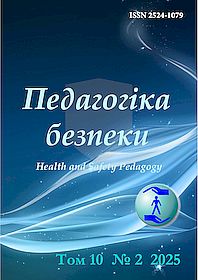Internet addiction among students: symptoms, consequences and methods of overcoming
DOI:
https://doi.org/10.31649/2524-1079-2025-10-2-092-102Keywords:
Internet addiction, digital literacy, mental health, social adaptation, cyber protection.Abstract
The article examines the problem of Internet addiction among young people, in particular students, which is becoming increasingly relevant in the modern digital world. The main symptoms and negative consequences of this disorder are analyzed, including decreased academic performance, emotional exhaustion, social isolation, sleep disturbances, and mental disorders. Particular attention is paid to factors contributing to the development of Internet addiction, such as emotional instability, anxiety, low self-esteem, and the desire to avoid real-life difficulties. Effective methods of prevention and correction of addiction are proposed, based on a comprehensive approach to psychological support, digital hygiene training, and the development of self-regulation skills.
The aim of the work is to study the impact of Internet addiction on student youth, identify the main factors of its development, analyze social, psychological, and academic consequences, and develop effective approaches to preventing and overcoming this disorder.
Based on the analysis, recommendations for the prevention of Internet addiction among students are proposed, which require a comprehensive approach that includes the development of self-awareness, digital literacy, and self-regulation skills. Educational institutions play an important role in this process, as they can provide access to qualified psychological counseling and create conditions for a healthy digital environment.
References
American Psychological Association. (2020). Health advisory on social media use in adolescence. Retrieved from https://www.apa.org/topics/social-media-internet/health-advisory-adolescent-social-media-use
Andreassen, C. S., et al. (2017). The relationship between addictive use of social media and video games and symptoms of psychiatric disorders: A large-scale cross-sectional study. Psychology of Addictive Behaviors, 31(3), 252–262. https://doi.org/10.1037/adb0000319.
Bartkiv, O. (2019). Sotsialno-pedahohichna profilaktyka Internet-adyktsii u studentskoi molodi [Socio-pedagogical prevention of Internet addiction in students]. Vyshcha shkola Skhidnoievropeiskoho natsionalnoho universytetu imeni Lesi Ukrainky. https://core.ac.uk/download/pdf/153580452.pdf. [in Ukrainian].
Buckingham, D. (2008). Youth, identity, and digital media. The MIT Press. [in English].
Caplan, S. E. (2002). Problematic Internet use and psychosocial well-being: Development of a theory-based cognitive–behavioral measurement instrument. Computers in Human Behavior, 18(5), 553–575. https://doi.org/10.1016/S0747-5632(02)00004-3.
Computer Economics. (2009). Internet Addiction Research Report. [Internal archive].
ESPAD Group. (2020). ESPAD Report 2019: Results from the European School Survey Project on Alcohol and Other Drugs. Publications Office of the European Union. https://doi.org/10.2810/970957
Goldberg, I. (1995). Internet Addiction Disorder. Retrieved from http://www.cog.brown.edu/brochure/people/duchon/humor/internet.addiction.html
Isaeva, E., & Sokolov, A. (2021). Communication strategy of a community of non-profit organizations and civic activists on social network sites: Problems and perspectives. Proceedings of the 2021 Communication Strategies in Digital Society Workshop (ComSDS), 43–46. https://doi.org/10.1109/ComSDS52473.2021.9422866.
Hrechanovska, O. V., Mehem, O. M., & Potapiuk, L. M. (2023). Vplyv sotsialnykh merezh na psykholohichnyi stan ta samootsinku ukrainskoi molodi. Scientific Notes of V. I. Vernadsky Taurida National University. Series: Psychology, 34(73)(4), 60–66. https://doi.org/10.32782/2709-3093/2023.4/11 [in Ukrainian]
Hryshko, V. V. (2021). Internet-zalezhnist studentiv [Internet addiction of students]. Visnyk psykholohii i pedahohiky. https://www.psyh.kiev.ua/%D0%86%D0%BD%D1%82%D0%B5%D1%80%D0%BD%D0%B5%D1%82-%D0%B7%D0%B0%D0%BB%D0%B5%D0%B6%D0%BD%D1%96%D1%81%D1%82%D1%8C_%D1%81%D1%82%D1%83%D0%B4%D0%B5%D0%BD%D1%82%D1%96%D0%B2. [in Ukrainian].
Kuss, D. J., & Griffiths, M. D. (2012). Internet Addiction: A Systematic Review of Epidemiological Research for the Last Decade. Current Pharmaceutical Design, 18(18), 4907–4918. [in English].
Kuss, D. J., & Griffiths, M. D. (2015). Internet Addiction in Psychotherapy. Palgrave Macmillan. https://doi.org/10.1057/9781137465078.
Kuss, D. J., van Rooij, A. J., Shorter, G. W., Griffiths, M. D., & van de Mheen, D. (2013). Internet addiction in adolescents: Prevalence and risk factors. Computers in Human Behavior, 29(5), 1987–1996. https://doi.org/10.1016/j.chb.2013.04.002.
Kuss, D. J., & Griffiths, M. D. (2017). Social networking sites and addiction: Ten lessons learned. International Journal of Environmental Research and Public Health, 14(3), 311. https://doi.org/10.3390/ijerph14030311.
Savenko S. M., Yurtseniuk O. S., & Rotar S.S. (2020). Internet-zalezhnist – tse tezh khvoroba [Internet addiction is also a disease]. https://www.bsmu.edu.ua/blog/5440-internet-zalezhnist-tse-tezh-hvoroba/. [in Ukrainian].
Weinstein, A., & Lejoyeux, M. (2010). Internet Addiction or Excessive Internet Use. The American Journal of Drug and Alcohol Abuse, 36(5), 277–283. https://doi.org/10.3109/00952990.2010.491880.
Yablonska, T., & Yuanjie, L. (2023). Psychological characteristics of young men with Internet addiction: A cross-cultural study. Scientific Bulletin of Mukachevo State University. Series “Pedagogy and Psychology”, 9(3), 91-101. https://doi.org/10.52534/msu-pp3.2023.91
Young, K. S. (1998). Internet addiction: The emergence of a new clinical disorder. CyberPsychology & Behavior, 1(3), 237–244. https://doi.org/10.1089/cpb.1998.1.237.
Young, K. S. (1999). Internet Addiction: Symptoms, Evaluation and Treatment. In Innovations in Clinical Practice: A Source Book, 17, 19–31.
Young, K. S. (2004). Internet Addiction: A New Clinical Phenomenon and Its Consequences. American Behavioral Scientist, 48(4), 402–415. https://doi.org/10.1177/0002764204270278.
Young, K. S. (2017). Internet addiction. In Internet Addiction: A Handbook and Guide to Evaluation and Treatment (pp. 3–16). John Wiley & Sons.
Yuan, K., Qin, W., Wang, G., Zeng, F., Zhao, L., Yang, X., ..., & Tian, J. (2011). Microstructure abnormalities in adolescents with Internet addiction disorder. PLoS One, 6(6), e20708. https://doi.org/10.1371/journal.pone.0020708.
Yurchenko, Ye. Yu. (2020). Internet-zalezhnist ta shliakhy yii podolannia u pidlitkovomu vitsi [Internet addiction and ways to overcome it in adolescence]. Kryvorizkyi derzhavnyi pedahohichnyi universytet. https://ekhsuir.kspu.edu/bitstream/handle/123456789/13726/%D0%AE%D1%80%D1%87%D0%B5%D0%BD%D0%BA%D0%BE%20%D0%84.%D0%AE..pdf?sequence=2&isAllowed=y. [in Ukrainian].
Yuryeva, L., & Shornikov, A. (2023). Cyber addiction: A new view and approaches to diagnostics. In Modern Methods of Diagnosing Diseases (pp. 132–161). Kharkiv: PC TECHNOLOGY CENTER. ISBN 978-617-7319-65-7. https://repo.dma.dp.ua/8390/ [in Ukrainian].
Zhou, Y., Lin, F. C., Du, Y. S., Qin, L. D., Zhao, Z. M., Xu, J. R., & Lei, H. (2011). Gray matter abnormalities in Internet addiction: A voxel-based morphometry study. European Journal of Radiology, 79(1), 92–95. https://doi.org/10.1016/j.ejrad.2009.10.025.
Downloads
-
PDF (Українська)
Downloads: 0



